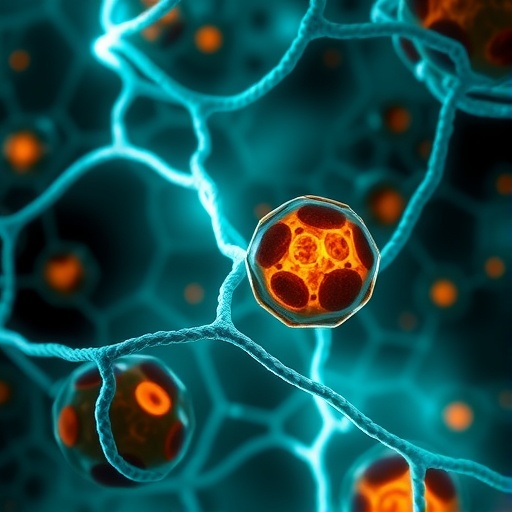
In a groundbreaking study poised to redefine therapeutic strategies for acute myeloid leukemia (AML), researchers have unveiled the pivotal role of the taurine transporter, SLC6A6, in leukemic stem cell (LSC) metabolism and disease progression. This transporter’s expression is markedly elevated in leukemia stem and progenitor cells when compared to their more differentiated blast counterparts, presenting a novel metabolic vulnerability that could be exploited to combat treatment-resistant AML subtypes. The discovery offers a beacon of hope for patients harboring venetoclax-resistant leukemia, a population currently facing limited effective treatment options.
The investigation began with comprehensive analyses of multiple gene expression datasets, revealing that SLC6A6 is ubiquitously expressed across AML cases independent of cytogenetic abnormalities or French-American-British (FAB) classification subtypes. Notably, higher expression levels of this transporter were correlated with resistance to venetoclax, a BCL-2 inhibitor that has revolutionized AML treatment but often encounters resistance in clinical settings. This finding indicates that SLC6A6 might contribute to the metabolic adaptations that enable leukemic cells to evade therapeutic pressure.
Further dissection of AML cellular heterogeneity demonstrated that SLC6A6 expression is particularly enriched in reactive oxygen species (ROS)-low leukemia stem cells within monocytic AML subtypes. These ROS-low LSCs are clinically associated with heightened resistance to venetoclax, suggesting that the taurine transporter supports a metabolic state conducive to cell survival under oxidative stress conditions. The study also revealed that leukemic cells bearing oncogenic RAS mutations exhibit amplified SLC6A6 expression relative to wild-type cells, an association aligned with previous data linking RAS pathway activation to therapeutic resistance.
Importantly, SLC6A6 expression was found to be increased in relapsed AML cases originating from stem or progenitor cell populations, underscoring the transporter’s likely involvement in disease persistence and relapse. Collectively, these multi-faceted insights emphasize SLC6A6 as a crucial player across the AML spectrum, particularly in subsets demonstrating refractoriness to current frontline treatments.
To translate these findings into therapeutic avenues, the researchers evaluated the efficacy of small-molecule inhibitors targeting taurine uptake via SLC6A6. Two structurally distinct taurine analogues, TAG (6-aminomethyl-3-methyl-4H-1,2,4-benzothiadiazine-1,1-dioxide hydrochloride) and GES (guanidinoethyl sulphonate), demonstrated potent inhibition of taurine transport in vitro. Treatment with these compounds significantly reduced colony formation by SLC6A6-competent mouse leukemia stem cells but had no effect on SLC6A6 knockout counterparts, affirming the specificity of action.
Notably, TAG and GES administration in primary human AML cells led to a pronounced suppression of colony-forming capacity, with reductions ranging from nearly two- to twenty-fold. These inhibitory effects were remarkably selective, as normal human hematopoietic stem and progenitor cells (HSPCs), characterized by CD34 positivity, were largely unharmed, indicating a therapeutic window that might minimize hematopoietic toxicity.
Given the clinical relevance of venetoclax and the frequent resistance that hampers its efficacy, the investigators probed whether combining venetoclax with taurine transporter inhibition could synergistically impair leukemic growth. The data were compelling: venetoclax alone decreased viability and colony formation in mouse LSCs, and when combined with either TAG or GES, the reduction in colony-forming units was not just additive but synergistic, with up to a 7.2-fold decrease observed. This synergy extended to primary human AML cells, where combined treatment induced colony formation reductions of up to 150-fold, a staggering potentiation relative to single-agent effects.
To circumvent the limitations of small-molecule inhibitors in vivo, particularly their inefficiency in fully blocking taurine uptake, the team employed shRNA-mediated knockdown of SLC6A6. This genetic approach confirmed that reducing SLC6A6 expression diminished taurine uptake by over two-fold and dramatically impaired colony formation in diverse myeloid malignancy cell lines, including blast crisis chronic myeloid leukemia (bcCML), AML, and myelodysplastic syndrome (MDS) models.
Critically, in patient-derived AML samples, SLC6A6 knockdown led to a 2.3- to more than 9-fold decrease in clonogenic potential without adversely affecting normal CD34+ HSPCs. This specificity was further validated in xenograft models, where SLC6A6 suppression curtailed the engraftment of primary human AML cells by up to 40-fold, while sparing normal hematopoietic progenitors. These findings outline a clear therapeutic window for targeting TAUT selectively in leukemic versus normal hematopoietic cells.
The implications of this work are profound. It delineates a previously underappreciated metabolic axis in AML pathogenesis, rooted in taurine uptake and utilization, and positions SLC6A6 as an attractive therapeutic target. By disrupting taurine-driven metabolic pathways, leukemic stem cells are rendered vulnerable, especially when combined with existing agents like venetoclax, opening new directions for treating drug-resistant AML.
This study exemplifies the power of integrating genomic, metabolic, and functional assays to uncover actionable targets in cancer stem cells, the elusive reservoir driving relapse and treatment failure. Future research will be required to optimize TAUT inhibitors for clinical use, elucidate the precise metabolic signaling downstream of taurine uptake, and explore combination regimens that may yield durable remissions in patients with aggressive myeloid leukemia.
Ultimately, targeting metabolic dependencies such as SLC6A6 provides a promising frontier in the war against AML, offering hope to patients whose disease no longer responds to conventional therapies. As the field advances, such targeted metabolic interventions may become staples in precision oncology, refining treatment paradigms and improving survival outcomes.
—
Subject of Research: Taurine transporter SLC6A6’s role in acute myeloid leukemia metabolism and therapeutic resistance.
Article Title: Taurine from tumour niche drives glycolysis to promote leukaemogenesis.
Article References: Sharma, S., Rodems, B.J., Baker, C.D. et al. Taurine from tumour niche drives glycolysis to promote leukaemogenesis. Nature (2025). https://doi.org/10.1038/s41586-025-09018-7
Image Credits: AI Generated
Tags: acute myeloid leukemia metabolismAML cellular heterogeneityBCL-2 inhibitor resistancegene expression in AMLleukemia stem cell resistancemetabolic vulnerabilities in leukemianovel treatment options for AMLreactive oxygen species in leukemiatargeting leukemic stem cellsTaurine transporter SLC6A6therapeutic strategies for AMLvenetoclax resistance in leukemia





